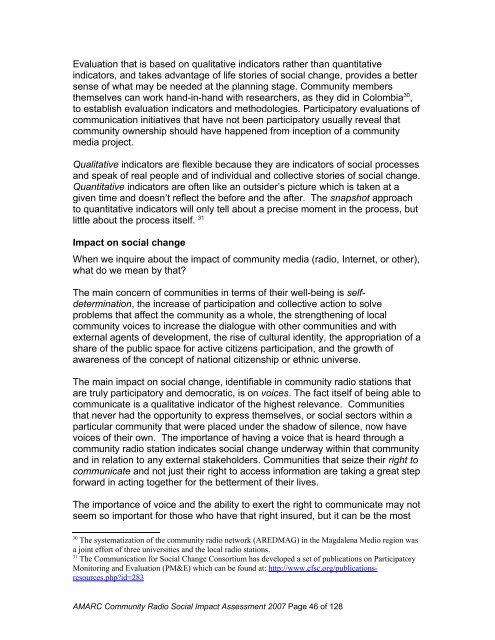Evaluation that is based on qualitative indicators rather than quantitativeindicators, and takes advantage of life stories of social change, provides a bettersense of what may be needed at the planning stage. Community membersthemselves can work hand-in-hand with researchers, as they did in Colombia 30 ,to establish evaluation indicators and methodologies. Participatory evaluations ofcommunication initiatives that have not been participatory usually reveal thatcommunity ownership should have happened from inception of a communitymedia project.Qualitative indicators are flexible because they are indicators of social processesand speak of real people and of individual and collective stories of social change.Quantitative indicators are often like an outsider’s picture which is taken at agiven time and doesn’t reflect the before and the after. The snapshot approachto quantitative indicators will only tell about a precise moment in the process, butlittle about the process itself. 31Impact on social changeWhen we inquire about the impact of community media (radio, Internet, or other),what do we mean by that?The main concern of communities in terms of their well-being is selfdetermination,the increase of participation and collective action to solveproblems that affect the community as a whole, the strengthening of localcommunity voices to increase the dialogue with other communities and withexternal agents of development, the rise of cultural identity, the appropriation of ashare of the public space for active citizens participation, and the growth ofawareness of the concept of national citizenship or ethnic universe.The main impact on social change, identifiable in community radio stations thatare truly participatory and democratic, is on voices. The fact itself of being able tocommunicate is a qualitative indicator of the highest relevance. Communitiesthat never had the opportunity to express themselves, or social sectors within aparticular community that were placed under the shadow of silence, now havevoices of their own. The importance of having a voice that is heard through acommunity radio station indicates social change underway within that communityand in relation to any external stakeholders. Communities that seize their right tocommunicate and not just their right to access information are taking a great stepforward in acting together for the betterment of their lives.The importance of voice and the ability to exert the right to communicate may notseem so important for those who have that right insured, but it can be the most30The systematization of the community radio network (AREDMAG) in the Magdalena Medio region wasa joint effort of three universities and the local radio stations.31The Communication for Social Change Consortium has developed a set of publications on ParticipatoryMonitoring and Evaluation (PM&E) which can be found at: http://www.cfsc.org/publicationsresources.php?id=283AMARC Community Radio Social Impact Assessment 2007 Page 46 of 128
meaningful social change indicator in communities that have never been heard.For example, the community audio towers in the Philippines have changed thelandscape of relations between small communities and local governments. InTacunan, à Barangay in Mindanao, members of the Community Media Council(CMC) emphasize that electricity, potable water and a new road were a result ofthe community being empowered through the community audio tower tocommunicate its demands to the authorities.Participation and ownership, which allow for the appropriation of thecommunication process, are indicators of impact because they are the result ofsocial transformation within the community. For participation to take place andevolve towards ownership, social changes have to happen in the relations ofpower within the community. Ownership of the communication process can onlytake place if the various sectors within a community can participatedemocratically, through their representatives or directly as citizens whose rightsare fully recognized in the community. Impact can be documented if, for example,groups of women have bettered their positions in terms of being heard andcontributing to decisions.The issue of horizontal communication is relevant not only for a radio stationestablishing a dialogue with other communities, but also the horizontal dialoguethat is established within the community, among various social sectors, to be partof the process of ownership.Collective action is another key indicator of impact. Communities able tocollectively strengthen their capacity to respond to the needs of development andsocial change through dialogue, through participation and through collectiveaction, are in a position to make decisions about the present and the future.Capacity or capability (reflection, analysis, learning from each other, problemsolving, and empowerment) is essential for development of freedom, ordevelopment as freedom. 32The role of AMARCAMARC has been the main network representing the movement of communityradio worldwide. Its growth has encompassed the development of thousands ofcommunity and local radio stations in Africa, Asia, Latin America and theCaribbean, and other regions of the world where community radio exists. AMARCis an association and at the same time a social movement with a politicalperspective, as stated in its main documents. It aims to “contribute to theexpression of different social, political and cultural movements and to thepromotion of all initiatives supporting peace, friendship among peoples.” .Through their programming, radio stations affiliated with AMARC are guided byprinciples reflecting respect: “the sovereignty and independence of all peoples;32“In this perspective, poverty must be seen as the deprivation of basic capabilities rather than merely aslowness of incomes, which is the standard criterion of identification of poverty.” Amartya Sen:Development as Freedom (1999) Alfred A. Knopf, Random House Inc. New York.AMARC Community Radio Social Impact Assessment 2007 Page 47 of 128
- Page 1 and 2: COMMUNITY RADIOSOCIAL IMPACTASSESSM
- Page 3 and 4: Chapter 10: Community Media by and
- Page 5 and 6: ForewordThe World Association of Co
- Page 7 and 8: monitoring and research process was
- Page 9 and 10: organizations interviewed tell only
- Page 11 and 12: The Roundtables, the electronic For
- Page 13 and 14: good. It did not involve a traditio
- Page 15 and 16: capabilities for monitoring, impact
- Page 17 and 18: Each of these components of the ext
- Page 19 and 20: Description of the ActivitiesThe th
- Page 21 and 22: PART II. Global Challenges to Commu
- Page 23 and 24: if we want to achieve poverty reduc
- Page 25 and 26: Community Radio is part of a politi
- Page 27 and 28: freedom of expression and military
- Page 29 and 30: has abandoned those responsibilitie
- Page 31 and 32: Chapter 5: The Amman Declaration 27
- Page 33 and 34: 10. Independent media can play a si
- Page 35 and 36: • Promote and support the trainin
- Page 37 and 38: communication strategies within the
- Page 39 and 40: This said, it becomes clear that in
- Page 41 and 42: as rural black women, impoverished
- Page 43 and 44: national languages. “For several
- Page 45: Measuring ImpactChapter 7: The Impa
- Page 49 and 50: Chapter 8: Why Assess Community Rad
- Page 51 and 52: doing the work they are chartered t
- Page 53 and 54: B. Assessing the effectiveness of c
- Page 55 and 56: • How do you participate in this
- Page 57 and 58: While community media can take many
- Page 59 and 60: From this perspective, communicatio
- Page 61 and 62: affordable means to express their o
- Page 63 and 64: At the same time there is growing r
- Page 65 and 66: Chapter 10: Community Media by and
- Page 67 and 68: Tallies from meetings showed that e
- Page 69 and 70: Chapter 11: What role did community
- Page 71 and 72: RM: [LAUGHS.] So we sang the news,
- Page 73 and 74: commission, tasked with developing
- Page 75 and 76: Most of the Eastern African countri
- Page 77 and 78: need to constantly be guided by ask
- Page 79 and 80: time are settled with custom law, i
- Page 81 and 82: Chapter 14: Community Radio and Med
- Page 83 and 84: ensuing global imbalance in informa
- Page 85 and 86: platforms and technologies? How can
- Page 87 and 88: CR should increase its role in faci
- Page 89 and 90: Clarifying the nature of Community
- Page 91 and 92: Amplify the voices of the poor and
- Page 93 and 94: Harmonize AMARC bodies and structur
- Page 95 and 96: (c) Solidarityactivitiesincludingre
- Page 97 and 98:
(d) Interactiveplatform forprogramm
- Page 99 and 100:
evaluation(d) Disseminationof resul
- Page 101 and 102:
expectations of AMARC relate to all
- Page 103 and 104:
Part VI : AnnexesAnnexe 1: Essentia
- Page 105 and 106:
One of the chapters is on “Progra
- Page 107 and 108:
customs and practices of the tribal
- Page 109 and 110:
http://portal.unesco.org/ci/en/file
- Page 111 and 112:
Radio Douentza was one of the first
- Page 113 and 114:
38. Querre, Francois. (1991). Les M
- Page 115 and 116:
Handbook for Developing Countries.
- Page 117 and 118:
The Pelican discussion, which has b
- Page 119 and 120:
Through the opinions of 30 communic
- Page 121 and 122:
andhttp://www.cfsc.org/pdf/measurin
- Page 123 and 124:
www.urcm.netUnited Grassroots Radio
- Page 125 and 126:
www.mci.gov.veZimbabwe So this is
- Page 127 and 128:
Please indicate how this impact cou
















